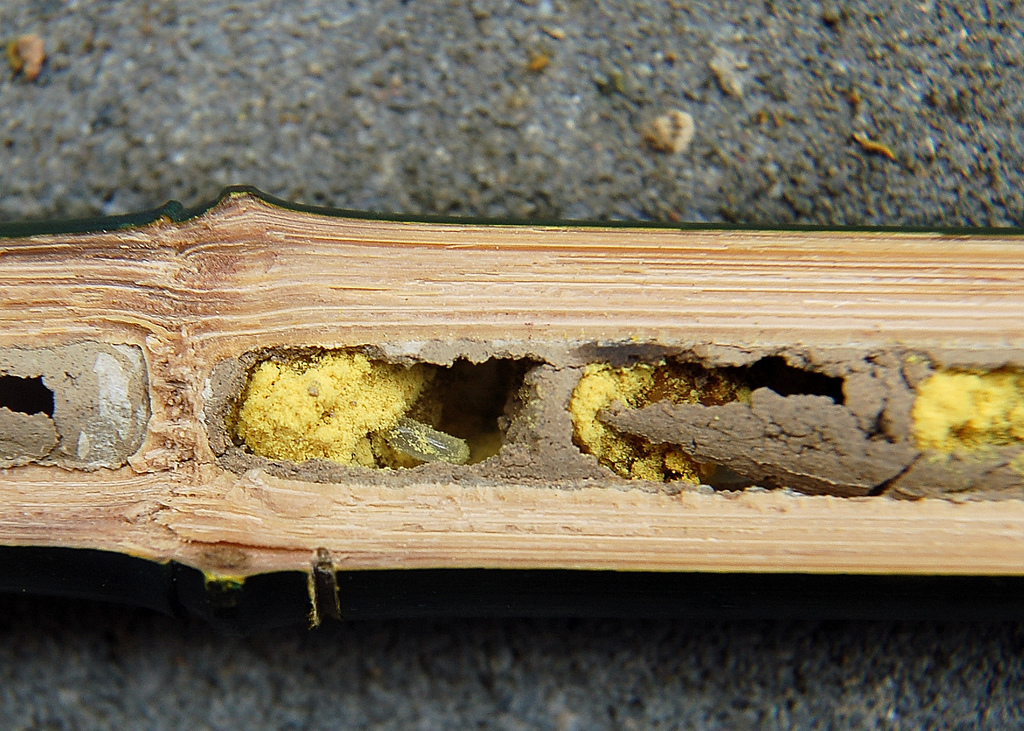|
Osmia Cornuta
''Osmia cornuta'', the European orchard bee, is a species of bee in the genus ''Osmia''. Description 10–15 mm. Males with conspicuously hairy faces. Females are unmistakable due to the black hair on the head and thorax, the rust-red hairy abdomen and the horned head shield.Making a bug Hotel, RHS Range ''Osmia cornuta'' is known in North Africa from Algeria, Tunisia and Egypt. In Eurasia from Portugal through southern and central Europe, Asia Minor and the Caucasus to Southeast Kazakhstan; northward to the North German Plain, Central Poland, Northern Ukraine and Voronezh; south to Sicily, Crete, Syria and Northern Iran. The evidence from Primorye is based on an error. The species was introduced to the United States for pollination purposes, but there are no reports of viable populations in the wild. In the ''ssp. divergens'' Friese, 1920 occurs from Iran to Central Asia; in the ''ssp. neoregaena'' Mavromoustakis, 1938 in the Aegean Islands and Cyprus; in the ''ssp. qu ... [...More Info...] [...Related Items...] OR: [Wikipedia] [Google] [Baidu] |
Pierre André Latreille
Pierre André Latreille (; 29 November 1762 – 6 February 1833) was a French zoologist, specialising in arthropods. Having trained as a Roman Catholic priest before the French Revolution, Latreille was imprisoned, and only regained his freedom after recognising a rare beetle species he found in the prison, ''Necrobia ruficollis''. He published his first important work in 1796 (), and was eventually employed by the . His foresighted work on arthropod systematics and taxonomy gained him respect and accolades, including being asked to write the volume on arthropods for George Cuvier's monumental work, , the only part not by Cuvier himself. Latreille was considered the foremost entomologist of his time, and was described by one of his pupils as "the prince of entomologists". Biography Early life Pierre André Latreille was born on 29 November 1762 in the town of Brive, then in the province of Limousin, as the illegitimate child of Jean Joseph Sahuguet d'Amarzit, général ... [...More Info...] [...Related Items...] OR: [Wikipedia] [Google] [Baidu] |
Germany
Germany,, officially the Federal Republic of Germany, is a country in Central Europe. It is the second most populous country in Europe after Russia, and the most populous member state of the European Union. Germany is situated between the Baltic and North seas to the north, and the Alps to the south; it covers an area of , with a population of almost 84 million within its 16 constituent states. Germany borders Denmark to the north, Poland and the Czech Republic to the east, Austria and Switzerland to the south, and France, Luxembourg, Belgium, and the Netherlands to the west. The nation's capital and most populous city is Berlin and its financial centre is Frankfurt; the largest urban area is the Ruhr. Various Germanic tribes have inhabited the northern parts of modern Germany since classical antiquity. A region named Germania was documented before AD 100. In 962, the Kingdom of Germany formed the bulk of the Holy Roman Empire. During the 16th ce ... [...More Info...] [...Related Items...] OR: [Wikipedia] [Google] [Baidu] |
Brassicaceae
Brassicaceae () or (the older) Cruciferae () is a medium-sized and economically important family of flowering plants commonly known as the mustards, the crucifers, or the cabbage family. Most are herbaceous plants, while some are shrubs. The leaves are simple (although are sometimes deeply incised), lack stipules, and appear alternately on stems or in rosettes. The inflorescences are terminal and lack bracts. The flowers have four free sepals, four free alternating petals, two shorter free stamens and four longer free stamens. The fruit has seeds in rows, divided by a thin wall (or septum). The family contains 372 genera and 4,060 accepted species. The largest genera are ''Draba'' (440 species), ''Erysimum'' (261 species), ''Lepidium'' (234 species), ''Cardamine'' (233 species), and ''Alyssum'' (207 species). The family contains the cruciferous vegetables, including species such as ''Brassica oleracea'' (cultivated as cabbage, kale, cauliflower, broccoli and collards), ... [...More Info...] [...Related Items...] OR: [Wikipedia] [Google] [Baidu] |
Berberidaceae
The Berberidaceae are a family of 18 genera of flowering plants commonly called the barberry family. This family is in the order Ranunculales. The family contains about 700 known species, of which the majority are in ''Berberis''. The species include trees, shrubs and perennial herbaceous plants. General The APG IV system of 2016 recognises the family and places it in the order Ranunculales in the clade eudicots. In some older treatments of the family, Berberidaceae only included four genera (''Berberis, Epimedium, Mahonia, Vancouveria''), with the other genera treated in separate families, Leonticaceae (''Bongardia, Caulophyllum, Gymnospermium, Leontice''), Nandinaceae (''Nandina''), and Podophyllaceae (''Achlys, Diphylleia, Dysosma, Jeffersonia, Podophyllum, Ranzania, Sinopodophyllum''). ''Mahonia'' is very closely related to ''Berberis'', and included in it by many botanists. However, recent DNA-based phylogenetic research has reinstated ''Mahonia'', though with a handfu ... [...More Info...] [...Related Items...] OR: [Wikipedia] [Google] [Baidu] |
Asteraceae
The family Asteraceae, alternatively Compositae, consists of over 32,000 known species of flowering plants in over 1,900 genera within the order Asterales. Commonly referred to as the aster, daisy, composite, or sunflower family, Compositae were first described in the year 1740. The number of species in Asteraceae is rivaled only by the Orchidaceae, and which is the larger family is unclear as the quantity of extant species in each family is unknown. Most species of Asteraceae are annual, biennial, or perennial herbaceous plants, but there are also shrubs, vines, and trees. The family has a widespread distribution, from subpolar to tropical regions in a wide variety of habitats. Most occur in hot desert and cold or hot semi-desert climates, and they are found on every continent but Antarctica. The primary common characteristic is the existence of sometimes hundreds of tiny individual florets which are held together by protective involucres in flower heads, or more technicall ... [...More Info...] [...Related Items...] OR: [Wikipedia] [Google] [Baidu] |
Asparagaceae
Asparagaceae, known as the asparagus family, is a family of flowering plants, placed in the order Asparagales of the monocots. The family name is based on the edible garden asparagus, ''Asparagus officinalis''. Those who live in the temperate climates may be surprised to learn that this family includes both common garden plants as well as common houseplants. The garden plants include asparagus, yucca, bluebell, and hosta, and the houseplants include snake plant, corn cane, spider plant and plumosus fern. Taxonomy In earlier classification systems, the species involved were often treated as belonging to the family Liliaceae. The APG II system of 2003 allowed two options as to the circumscription of the family: either Asparagaceae ''sensu lato'' ("in the wider sense") combining seven previously recognized families, or Asparagaceae ''sensu stricto'' ("in the strict sense") consisting of very few genera (notably ''Asparagus'', also ''Hemiphylacus''), but nevertheless totalling ... [...More Info...] [...Related Items...] OR: [Wikipedia] [Google] [Baidu] |
Holly
''Ilex'' (), or holly, is a genus of over 570 species of flowering plants in the family Aquifoliaceae, and the only living genus in that family. ''Ilex'' has the most species of any woody dioecious angiosperm genus. The species are evergreen or deciduous trees, shrubs, and climbers from tropics to temperate zones worldwide. The type species is '' Ilex aquifolium'', the common European holly used in Christmas decorations and cards. Description The genus ''Ilex'' is divided into three subgenera: *''Ilex'' subg. ''Byronia'', with the type species ''Ilex polypyrena'' *''Ilex'' subg. ''Prinos'', with 12 species *''Ilex'' subg. ''Ilex'', with the rest of the species The genus is widespread throughout the temperate and subtropical regions of the world. It includes species of trees, shrubs, and climbers, with evergreen or deciduous foliage and inconspicuous flowers. Its range was more extended in the Tertiary period and many species are adapted to laurel forest habitats. It occurs ... [...More Info...] [...Related Items...] OR: [Wikipedia] [Google] [Baidu] |
Aceraceae
Aceraceae were recognized as a family of flowering plants also called the maple family. They contain two to four genera, depending upon the circumscription, of some 120 species of trees and shrubs. A common characteristic is that the leaves are opposite, and the fruit a schizocarp. The maples have long been known to be closely related to the family Sapindaceae. Several taxonomists (including the Angiosperm Phylogeny Group) now include both the Aceraceae and the Hippocastanaceae in the Sapindaceae. Recent research (Harrington et al. 2005Harrington, M. G., Edwards, K. J., Johnson, S. A., Chase, M. W., & Gadek, P. A. (2005). Phylogenetic inference in Sapindaceae sensu lato using plastid matK and rbcL DNA sequences. ''Systematic Botany'' 30: 366-382Abstract) has shown that while both Aceraceae and Hippocastanaceae are monophyletic in themselves, their removal from Sapindaceae ''sensu lato'' would leave Sapindaceae ''sensu stricto'' as a paraphyletic group, particularly with referenc ... [...More Info...] [...Related Items...] OR: [Wikipedia] [Google] [Baidu] |
Osmia Bicornis
''Osmia bicornis'' (synonym ''Osmia rufa'') is a species of mason bee, and is known as the red mason bee due to its covering of dense gingery hair. - Swarm-like behaviour of red mason solitary bees - retrieved 2013-08-14INSECTS - Collins gem guide /ref> It is a solitary bee that nests in holes or stems and is polylectic, meaning it forages pollen from various different flowering plants. These bees can be seen aggregating together and nests in preexisting hollows, choosing not to excavate their own. These bees are not aggressive; they will only sting if handled very roughly and are safe to be closely observed by ... [...More Info...] [...Related Items...] OR: [Wikipedia] [Google] [Baidu] |
Scilla
''Scilla'' () is a genus of about 30 to 80 species of bulb-forming perennial herbaceous plants in the family Asparagaceae, subfamily Scilloideae. Sometimes called the squills in English, they are native to woodlands, subalpine meadows, and seashores throughout Europe, Africa and the Middle East. A few species are also naturalized in Australasia and North America. Their flowers are usually blue, but white, pink, and purple types are known; most flower in early spring, but a few are autumn-flowering. Several ''Scilla'' species are valued as ornamental garden plants. Taxonomy Species of ''Scilla'' have been known since classical antiquity, being described by both Greek (Theophrastus (371–287 BC) and Discorides (40–90 AD)) and Roman (Pliny (23–79 AD)) writers. Theophrastus described ''Scilla hyacinthoides'' (''skilla''), and more briefly '' S. autumnalis'' and '' S. bifolia'' in his ''Historia plantarum'', where he mentions "those of squill" (σκῐ́λ� ... [...More Info...] [...Related Items...] OR: [Wikipedia] [Google] [Baidu] |
Anthophora Plumipes
The hairy-footed flower bee (''Anthophora plumipes'') is a species of bee belonging to the family Apidae. Distribution These bees are widespread in most of Europe and Asia from Britain to China and Japan, the Near East and in North Africa. In the 20th century, the species was introduced to the United States. The species was spotted for the first time in Ireland in April 2022. Habitat The ''hairy-footed flower bees'' commonly inhabit gardens, open woodland, and coastal sites. Description The adults of ''Anthophora plumipes'' grow up to long. There are numerous color forms over the species' geographic range, which have resulted in this species being described under many different names. This species shows an evident sexual dimorphism. The body is always densely hairy. Males have most often bright reddish brown or gray hair, while females are usually all black or dark brown. Furthermore, the females show reddish orange scopal hairs on the hind tibia. The middle legs of males ar ... [...More Info...] [...Related Items...] OR: [Wikipedia] [Google] [Baidu] |
Synanthrope
A synanthrope (from the Greek σύν ''syn'', "together with" + ἄνθρωπος ''anthropos'', "man") is a member of a species of wild animal or plant that lives near, and benefits from, an association with human beings and the somewhat artificial habitats that people create around themselves (see anthropophilia). Such habitats include houses, gardens, farms, roadsides and rubbish dumps. The category of synanthrope includes many species regarded as pests or weeds. It does not, however, include domesticated animals such as cattle, honeybees, pets, poultry, silkworms, and working animals. Examples of synanthropes are various insect species ( lice, ants, silverfish, cockroaches, etc.), house sparrows, rock doves (pigeons), crows, various rodent species, Virginia opossums, raccoons, certain monkey species, coyotes, deer, urban ferals, passerines, and other urban wildlife. Plants include Pineapple Weed, Dandelion, Chicory, and Plantain. The brown rat is counted as one of th ... [...More Info...] [...Related Items...] OR: [Wikipedia] [Google] [Baidu] |




